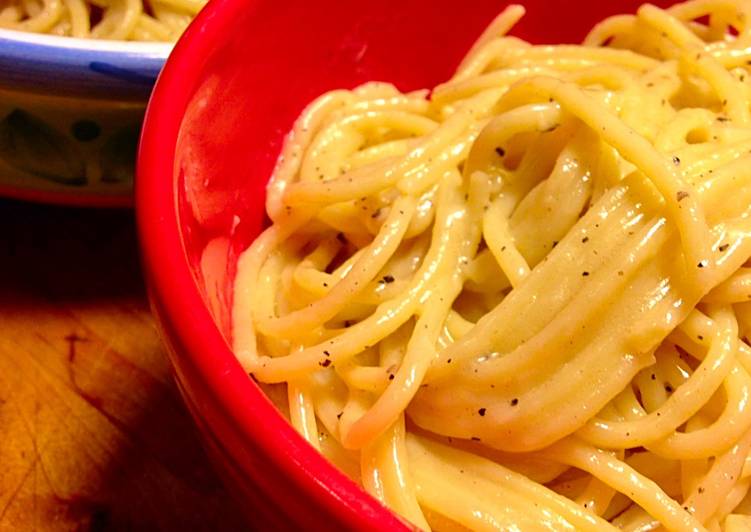Cacio e Pepe - Recettes simples pour la maison. Mix Pecorino and fresh ground pepper in a bowl, boil pasta in salted water, lift pasta into the bowl with cheese and. Cacio e pepe (Italian pronunciation: [kaˈtʃo e ˈpeːpe]) is a pasta dish from modern Roman cuisine. "Cacio e pepe" means "cheese and pepper" in several central Italian dialects. This is how to make real cacio e pepe , the classic Roman pasta dish. Cacio e pepe is one of the simplest pasta dishes to make but it can be a bit tricky. Cacio e pepe literally translates to "cheese and pepper," and while those are the prominent flavors here, this dish is SO much more.
 Cacio e pepe is the most divine pasta dish made with simple, high quality ingredients.
Tender noodles tossed in a two-cheese blend and a hint of cream ensure luscious forkfuls.
The name is cacio e pepe: cheese and pepper.
Cacio e pepe is the most divine pasta dish made with simple, high quality ingredients.
Tender noodles tossed in a two-cheese blend and a hint of cream ensure luscious forkfuls.
The name is cacio e pepe: cheese and pepper.
Vous pouvez faire cuire Cacio e Pepe avec 5 épices et 8 étapes. Voir le guide suivant!
Ingrédients de Cacio e Pepe:
- 1 salt.
- 1 lb spaghetti.
- 1/4 cup olive oil.
- 2 tbsp whole black peppercorns.
- 6 oz peccorino, grated.
The addition of garlic changes the dish but it is still tasty. Chef Massimo Bottura gave us the recipe for this creamy risotto, a take on the classic Roman pasta dish cacio e pepe that he developed after earthquakes devastated the. The classic Roman pasta dish cacio e pepe is as easy to make as it is delicious. If you were to watch a practiced hand make cacio e pepe, you might think the instructions were as simple as this: Cook.
Comment cuisiner Cacio e Pepe:
- Cook spaghetti to just under al dente. Steps 2 and 3 can be performed as the pasta cooks. https://cookpad.com/us/recipes/355982-how-to-cook-dry-pasta.
- Using a mortar and pestle, grind the black pepper. The pepper should be pretty well ground, but it's nice to leave some larger chunks in the mix, sparks of flavor as they crush between your teeth..
- Heat olive oil in a pan large enough to accommodate your spaghetti. When the oil begins to bubble, toss in the black pepper. Stir over heat until the aroma of toasting black pepper hits you in the face. Quench the pan with a ladle of pasta water and remove from heat. Set aside..
- When the spaghetti is a couple minutes from being done, return the pepper infused water to a boil and make sure that your grated cheese is close at hand..
- As the spaghetti nears doneness, just to the point that you would almost want to eat it, use a pasta spoon to scoop out and transfer the noodles from the boiling pasta water to the simmering sauce. Don't discard the pasta water just yet..
- Continue cooking the pasta in the pepper sauce, adding small ladles of pasta water as needed, until the spaghetti is cooked to your liking. Be careful not to overseason. That pasta water should be pretty salty..
- With the noodles perfectly cooked and some water remaining in the bottom of the pan, quickly remove the pan from heat and stir in the grated pecorino. The cheese should dissolve into a velvety sauce, almost as though you'd used egg as you would in a carbonara. This final step can take a little practice. You need the right temperature and the right amount of water left in the pan to get that awesome creamy texture. Keep at it. At least the mistakes are edible..
- To serve, just double check and adjust the seasoning before you scoop a portion into a bowl and get to work..
The traditional pasta used for cacio e pepe is tonnarelli, sometimes sold as spaghetti alla chittara, a squared-off, slightly thicker spaghetti. Cacio e Pepe with Peas and Favas. Add the flour to a mixing bowl and make a well in the middle. Want to know Padella's pici cacio e pepe recipe? Skip the queues at Padella Borough Market for homemade pici cacio e pepe (pici pasta with parmesan, black pepper and garlic).